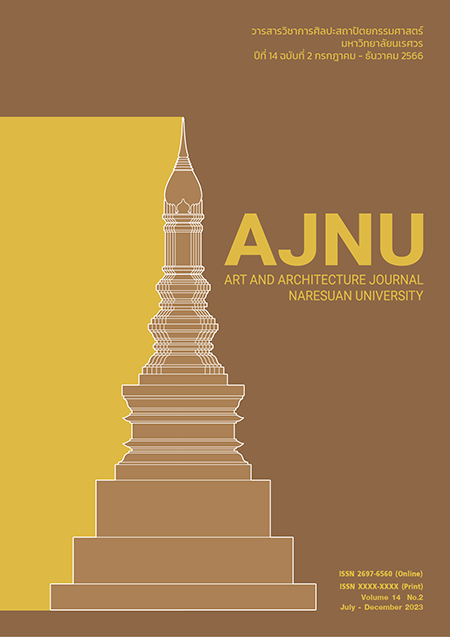Eco-printing: The study of color fixing quality from natural raw material and natural mordant
Main Article Content
Abstract
This research aims to study the quality of cotton fabric using natural raw materials and different mordants. The core factors of this study are different types of leaves and mordants. Four samples of leaves were chosen for the study; Indian Almond, Teak, Indian trumpet flower and eucalyptus; while the particular types of mordants used for this study are alum water, limewater and tamarind juice for eco-printing techniques from natural materials on fabric. The dyed fabric was then tested using CIELab color system. The results reveal that each types of leaves produced diverse colors; three L* values are between 57.48-73.60 with the a* value on the positive scale resulting the magentaish color and the b* value, similarly on the positive scale, resulting the yellowish color. The colors produced from this process is categorized as a warm tone; yellow and yellowish-green colors. These colors coveys energetic, lively, strong, positive, solid and pleasant feelings. The colors from Indian trumpet flower leaves are the brightest and most intense. The shapes and colors on dyed fabric differ from leaf to leaf. When using different mordants, the fabric fermented in alum water displays the most vivid colors; while limewater mordants produced earth tone colors. Printed fabric using tamarind juice as a mordants demonstrates duller and strong chroma colors. Each fabric has its own unique characteristics, however, when comparing the clarity and intensity of natural dye on each fabric, it is found that the limewater-fermented fabric illustrates the most clearest and intense colors of all four leaves.
Article Details

This work is licensed under a Creative Commons Attribution-NonCommercial-NoDerivatives 4.0 International License.
References
ชญตว์ อินทร์ชา. (2562). การศึกษาศิลปะภาพพิมพ์เทคนิคเพลทแม่พิมพ์เจลลาตินด้วยการใช้สีธรรมชาติในท้องถิ่นของ
มหาวิทยาลัยราชภัฏร้อยเอ็ด. วารสารมนุษยศาสตร์และสังคมศาสตร์ มหาวิทยาลัยราชภัฏอุดรธานี, 8(2), 109-124.
ณภัทร ยศยิ่งยง. (2557). การพัฒนาของสีและเฉดสีของผ้าฝ้ายที่ย้อมด้วยวัสดุสีธรรมชาติ (รายงานการวิจัย). สืบค้นเมื่อ
มิถุนายน 2564, จาก https://dspace.rmutk.ac.th/handle/123456789/1506
ปาเจรา พัฒนถาบุตร. (2551). กระบวนการย้อมสีธรรมชาติ. นครปฐม: โรงพิมพ์มหาวิทยาลัยศิลปกร
ภัทรานิษฐ์ สิทธินพพันธ์ พริยะ แก่นทับทิม และประเทืองทิพย์ ปานบํารุง. (2557). การพัฒนาลวดลายผลิตภัณฑ์ต้นแบบผ้ามัดย้อมด้วยการย้อมจากสีธรรมชาติ. Interdisciplinary Research Review. 9(1) 81 - 89
มหาวิทยาลัยราชภัฏพิบูลสงคราม. การวัดสีและความเข้มสี (ภาคผนวก). สืบค้นเมื่อ 10 มิถุนายน 2564, จาก
https://research.psru.ac.th/files/res_che2553/resche_files/402_appendix.pdf
วัลภา แต้มทอง และสุธีลักษณ์ ไกรสุวรรณ. (2560). ผลของไฮโดรเจนเปอร์ออกไซด์ต่อค่าดัชนีความขาวและความแข็งแรงของ
เปลือกข้าวโพด. วารสารมหาวิทยาลัยศรีนครินทรวิโรฒ (สาขาวิทยาศาสตร์และเทคโนโลยี), 9(17), 127-136.
วีระศักดิ์ ศรีลารัตน์ และณัฐสิมา โทขันธ์. (2564). การเพิ่มมูลค่าบัวหลวงด้วยภูมิปัญญาผ้าฝ้ายมัดย้อมสีธรรมชาติ. วารสารการ
พัฒนาชุมชนและคุณภาพชีวิต, 9(2), 205-212.
สมชญา ศรีธรรม และคณะ. (2563). ความหลากชนิดของไม้ต้นและการใช้ประโยชน์ด้านการให้สีย้อมธรรมชาติ: กรณีศึกษา ป่า
ชุมชนในจังหวัดสุรินทร์. วารสารเกษตรศาสตร์และเทคโนโลยี, 1(2), 17-32.
สำนักงานนโยบายและทรัพยากรธรรมชาติและสิ่งแวดล้อม. (2554). รายงานสถานการณ์คุณภาพสิ่งแวดล้อม พ.ศ. 2554.
กรุงเทพมหานคร.
สุวิมล หงษ์สาม ทรงวุฒิ เอกวุฒิวงศา และพิชัย สดภิบาล. (2557). ศึกษาและพัฒนากระบวนการเพิ่มจำนวนเฉดสีย้อมธรรมชาติ
บนผ้าฝ้ายด้วยห้อมเพื่อประยุกต์ใช้ในการออกแบบผลิตภัณฑ์สิ่งทอ. วารสารวิชาการศิลปะสถาปัตยกรรมศาสตร์
มหาวิทยาลัยนเรศวร, 5(2), 72-85.
สุวิมล อุทัยรัศมี. (2560). ปริมาณและองค์ประกอบทางเคมีของน้ำมันหอมระเหยจากใบยูคาลิปตัส 9 สายต้น ที่ปลูกในประเทศ
ไทย.วารสารวนศาสตร์, 36(1), 1-10.
โสภาพรรณ ซอหะซัน. (2562). การพัฒนาสารกั้นสีธรรมชาติจากแป้งเมล็ดขนุนสำหรับผ้าบาติก วิทยานิพนธ์มหาบัณฑิต
(คศ.ม). ปทุมธานี: มหาวิทยาลัยเทคโนโลยีราชมงคลธัญบุรี.
อมรรัตน์ อนันต์วราพงษ์ พีรพงษ์ หนูแดง บุณฑริกา ปริมาณ สถาพร จิรบูรณ์ และศุภาสี วงษ์ทองดี. (2560). การพัฒนา
ผลิตภัณฑ์ผ้าบาติกด้วยเทคนิคผสมโดยใช้สีธรรมชาติ. วารสารวิชาการแพรวากาฬสินธุ์ มหาวิทยาลัยกาฬสินธุ์, 4(2),
-222.


